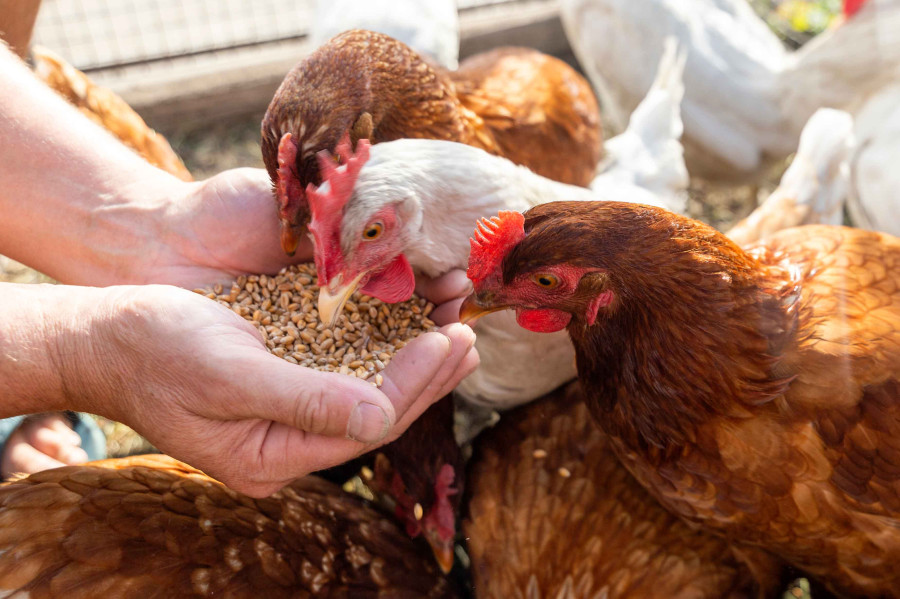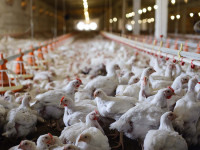Money
Quality watchdog proposes amending feed standards
Inferior poultry diets could cause nutritional stress that could lead to human health concerns, officials say.
Krishana Prasain
The government’s quality watchdog has recommended enforcing new feed standards claiming that inferior poultry diets without the right mix of nutrients were potentially causing nutritional stress that could lead to human health concerns.
The Department of Food Technology and Quality Control has urged the government to cancel the existing poultry feed standards that were implemented in December 2007.
“We have decided to upgrade the quality and permissible elements doses in poultry feed as the existing feeds have been found to be indirectly impacting human health,” said Mohan Krishna Maharjan, senior food research officer on Sanitary and Phytosanitary Measures (SPS) National Enquiry Point under the Department of Food Technology and Quality Control.
“If the feed contains mycotoxin, it contaminates livestock products like milk, egg and meat. That’s why it is vital to maintain the standards and quality of feeds as per the changing times.”
The department has proposed upgraded quality standards for poultry feed and sent them to the Ministry of Agriculture and Livestock Development.
"The ministry will notify the World Trade Organisation," Maharjan said. “We have added some specifications in the new standards.
According to Rabin Puri, president of the Nepal Feed Industries Association, there are 118 small and big factories in the country producing 3,200 tonnes of poultry feed daily.
Output totalled 3,500 tonnes daily before the pandemic. According to Puri, the feed industry has a combined investment of Rs40 billion.
Almost 85 percent of the raw materials used to make livestock feed, including maize and oil cakes, are imported, mainly from India and the United States.
Poultry has been the meat of choice for consumers in the developing countries, including Nepal, because it is cheaper, according to reports.
Because of the expected slow growth in incomes, poultry meat will continue to account for the largest share of additional per capita consumption at the global level, experts said.
According to the statistics of the Ministry of Agriculture and Livestock Development, annual meat production stood at 520,742 tonnes in the fiscal year 2020-21. Out of the total output, the share of poultry meat came to 43.58 percent or 226,959 tonnes.
The country produces meat worth Rs275 billion annually.
According to the ministry’s report, a Nepali eats 18 kg of meat per year. Per capita meat consumption was 9.8 kg per year in 2008 and 9.7 kg in 2000.
The ministry’s statistics also show that Nepal produces 1.49 billion eggs annually.
Chickens are produced commercially in 64 of the country's 77 districts, and 55,871 people are engaged in the business. Commercial chicken production began in 1974. Between 2004 and 2013, a large number of farmers shifted to poultry.
The quality watchdog said that with the boom in the poultry industry, concerns have been raised about the quality of poultry feed.
“The essential composition and quality factors of poultry feed can be in any form like pellets, crumbs or powder,” said Maharjan.
The raw materials used for feed are maize, broken rice, sorghum, wheat, barley, rice, ragi, cassava flour, vegetable oil, soybean flour and oil cake, peanut flour, rapeseed oil cake, sunflower oil cake and sesame oil cake, among others.
Similarly, fish powder, maize gluten, rice bran, rice bran de oiled cake, wheat remaining, sal seed meal, molasses, lime stone powder, dicalcium phosphate, edible salt, edible soda and shell grit are used as raw materials to produce poultry feed.
“The poultry feed should not be decayed, stink, poisonous or contain fungus and insects,” the upgraded poultry standards states.
To boost or maintain the quality of poultry feed, feed supplements and feed additives containing nutrient elements can be used according to need; but antibiotics should not be used, as per the draft standards.
The government has also proposed the maximum permissible limit for harmful elements. The maximum limit of arsenic should not be more than 2.0 mg per kg, fluorine 30 mg per kg, lead 5 mg per kg, mercury 1 mg per kg, and sodium nitrite 15 mg per kg.
The highest permissible limit of castor is 10 mg per kg, free gossypol 20 mg per kg, aflatoxin B1 28 per microgram per kg and no non-protein nitrogen.
The maximum limits for residues, contaminants and toxins, among other harmful elements, are as determined by the government.
The work procedure regarding production, packaging, handling, storage and sanitation in transportation will be determined by the Ministry of Agriculture and Livestock Development.
Poultry feed needs to be packaged in a clean and dry polythene laminated jute sack or laminated paper bag.
The label on the packaging should show the brand name and the name of the feed, type of feed, name and address of the producers, quantity, maximum retail price, batch number, production and consumption dates, details of the ingredients and storage method.
The government has fixed the quality standards of feed for birds of various types from chicks to broilers.
The moisture content in feed should not be more than 11 percent. The maximum moisture content when a mould inhibitor or acidifier is used should not be more than 12 percent.
The minimum crude protein should be 20 percent for 0-8 months layers, 16 percent for 9-19 months layers, 18 percent for 17-45 months layers and 16 percent for 45 months layers.
The minimum crude protein should be 22 percent for 14 days broiler, 21 percent for broiler of 15-28 days, 20 percent for 29-42 days broiler and 19 percent for 43 days broiler.
The maximum limit of crude fibre in layers should not be more than 6 percent for 0-8 weeks layers, 8 percent for 9-16 weeks layers, 8 percent for 17-45 weeks layers and 9 percent for 45 weeks layers.
The maximum crude fat should be a minimum of 2 percent for all types of layers and 3.5 percent for all types of broilers. The maximum acid insoluble ash should be 4 percent in all types of layers and 3.5 percent in all types of broilers.
The minimum calcium for layers should be 1 percent in 0-8 weeks layers and 9-16 weeks layers while it should be 3 percent for 17-45 weeks layers and 3.5 percent for 45 weeks layers.
The minimum calcium in broiler feed should be 1 percent.
The maximum salt as sodium chloride should be 0.5 percent for layers and broilers.
The minimum total phosphorous for layers of 0.8 weeks should be 0.7 percent and 0.65 percent for all other layers. The minimum total phosphorous for broilers should be 0.7 percent.




 11.12°C Kathmandu
11.12°C Kathmandu













%20(1).jpg&w=300&height=200)
